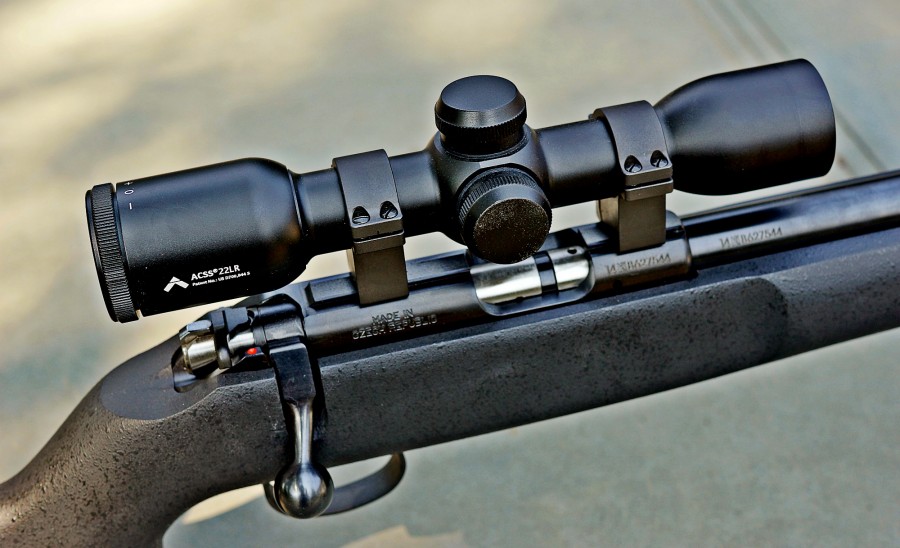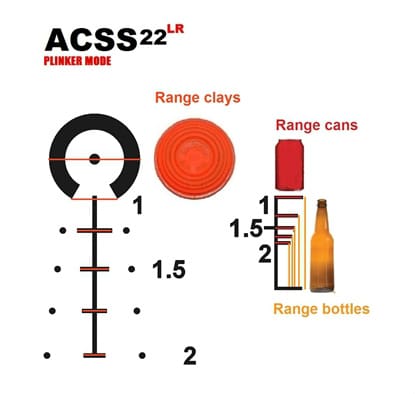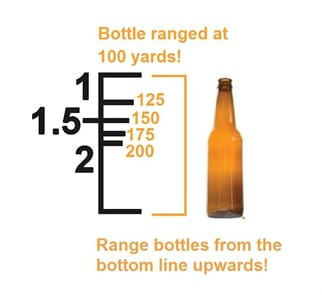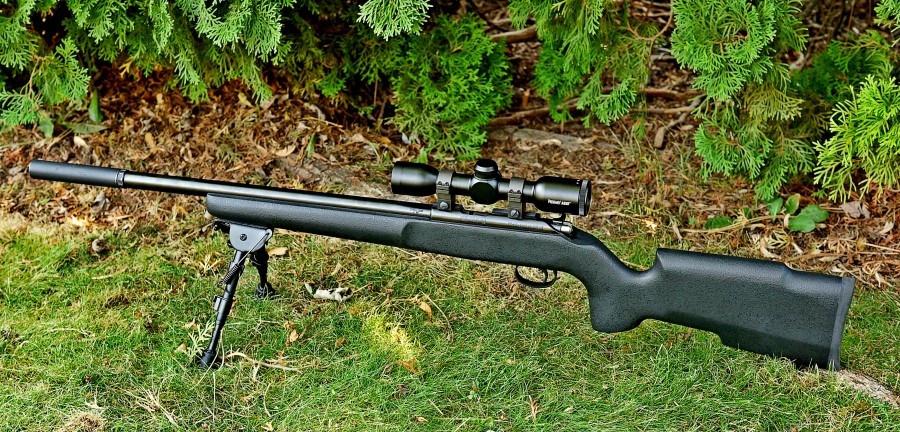March 11, 2014: the U.S. Patent Office approves a patent for the Advanced Combat Sighting System, or ACSS. This novel reticle design combines near-instant, intuitive ranging of human targets out to 800 yards with built-in bullet drop, windage, and running target compensation markings. A full review of Primary Arms’ 1-6X ACSS is forthcoming. But, for those looking to range and engage targets a little less grave than enemy combatants, today we’re checking out a version of the ACSS reticle designed for ranging clay pigeons, cans, and bottles out to 200 yards. It’s built into the Primary Arms 6X 22LR scope. . .
The Reticle
The reticle is the star of the show, so let’s start there.
Sporting clays are ranged via the horseshoe and center tape. If the width of the clay is horseshoe-sized or larger, aim true with the center dot, which you’ve zeroed at 50 yards. If it’s the width of the open bottom of the horseshoe, it’s 100 yards away and you’re already aiming with the top of the post. If you’ve matched the width of the first horizontal line with the clay, it’s 125 yards away. Pull the trigger, you’re already lined up to compensate for the bullet’s drop. If it’s the width of the bottom line, it’s 200 yards away. Pull the trigger. Cross wind? Those dots on either side of the tape are your holds for a 5 MPH wind. Halve the hold for half that, double it for double that.
On the right side of the reticle is a ranging tape for cans and bottles. The horizontal width of the top five lines corresponds to the width of a can at 100, 125, 150, 175, and 200 yards. To range a bottle, measure from the bottom, up.
Once you’ve ranged your can or bottle, use the center tape to align the appropriate crosshair with the target. Squeeze that trigger. It works. It’s freakin’ easy. Yes, you too can hit clays, cans, and bottles with a .22 — with confidence — out to 200 yards. Time to win some bets.
Oh, and if you’re more of the varmint hunting type, there are a lot of critters that can be easily compared for size against these three items that we’re all so familiar with. Heck, a clay pigeon approximates the body size of a lot of birds, eh.
The Scope
Like the “real” ACSS, this .22 reticle variant is simply awesome. But let’s not forget that it has to go in some sort of optic and there’s plenty of opportunity to screw up a good thing with a cheap, unreliable scope. At an MSRP of $119.99 I was a bit worried that a cheap scope is precisely what I’d receive, but instead I got an inexpensive one.
The quality of the glass is better than you’d expect from a Chinese-made scope in this price range. In fact, one of the reviews on Primary Arms’ website claims the clarity in this little 6X is better than a 4X rimfire Leupold. That I cannot confirm or deny, but it certainly is bright and crisp as this cell phone photo attempts to show:
Purged, fog resistant, waterproof, and multi-coated.
Diopter is adjustable to maintain a clear reticle despite your wonky eyesight.
Turrets click cleanly and solidly without the need for tools. Each click is 1/4 MOA. By loosening the two bolts and removing the turret, it can be re-zeroed against the zero indicator dot.
The tube is 1″ in diameter, and I believe is a one-piece aluminum extrusion. 
On The Range
I struck out for the woods of N’Idaho and randomly placed clay pigeons and cans of Ruby Red Squirt as far out as I had line-of-sight through the thick forest. The actual ranges to any of the targets were not known, leaving it for the reticle to determine.
And determine range it did. I worked my way out to about 75 yards, hitting every target on the way, and then decided to skip to the farthest clay pigeon out there. It fit somewhere in between the 125- and 150-yard dashes — closer to the 150 though — so I held appropriately…and…center punched the clay. The middle broke, but the outer ring was still sitting on the fallen tree. Held again, just higher this time, and nailed the ring. Splash one clay. My laser rangefinder later confirmed the distance at about 140 yards.
The farthest target, though, was the Squirt can seen above. This betrayed a bit of a weakness in the .22 reticle, which is a lack of illumination. The black ranging tape was difficult to see against the dark can hiding in the heavy shade of thick forest. The reticles were visible enough to use for accurate shooting, but were too hard to see for ranging purposes. Clays, thanks to their near-neon color, caused no such issue.
Still, knowing the can was a few yards farther than the farthest clay, I just centered the 150-yard crosshair on it and…missed. A slight side-to-side breeze had kicked up and it was enough to drift the bullet off target. I used a half-5mph-dot windage hold and drilled it. Squirt squirt.
For the record, the bullet drop compensation is aligned with the velocity of most bulk box ammunition as well as CCI’s Mini-Mag. Basically, anywhere from about 1,200 fps to 1,300 fps and you’re dead-on. That said, I also had great success with subsonic rounds at 980 fps by simply adding like 30% to the range estimations (e.g. range a can at 100, hold for 130).
Conclusions
My impression of the weight and feel of the scope isn’t extremely high, but functionally it has been a rock star. Turret adjustments are spot-on and solid, glass is great, reticle is clear. And, man, the reticle. How freaking cool is that? It just flat-out works.
Gone are the days of walking in .22s at long ranges or wildly taking a stab at range estimation. This thing’s like a magic trick, and I fully intend to win money from my friends with it.
Specifications: Primary Arms 6X Scope with ACSS 22LR Reticle
- Tube Diameter: 1″
- Magnification: 6X
- Exit Pupil: 5.2mm
- Eye Relief: 3.2″
- Field of View: 17.5 ft @ 100 yds
- Click Value: 1/4 MOA
- Waterproof
- Fog resistant
- Black anodized matte finish
- Length: 9.25″
- Weight: 12 oz
- Protective bikini covers included
- Three-year manufacturer warranty
- MSRP: $119.99
Ratings (out of five stars):
Feel & Function * * * *
A bit of a mixed bag here, as I think externally the scope feels and looks cheap. However, the turret adjustment feel is quite good, and functionally this thing is totally solid. The range-finding, BDC reticle rocks harder than a convertible on prom night.
Glass Quality * * * *
Definitely great for the price.
Reticle * * * * *
Yup, awesome. Just to spoil the 1-6X review, it’s amazing also. I slapped it on my AR, zeroed it at 100, and proceeded to just drill steel all the way out to a half mile. Range estimation is so darn easy, and the BDC holds are dead-on.
Overall * * * * *
Love it. Fixed 6X zoom is great for 25 to 200 yards, image is bright and clear and parallax-free, price is reasonable, and the way the ranging and bullet drop compensation work together is as intuitive, easy, and effective as it gets.














I ran it through a box drill last night, by the way. Full rotation up and right, two rotations down, two rotations left, two rotations up, one rotation down and right. The box is square and the last group in the center was on top of the first group. I’ll link to a photo here shortly…
Everywhere I have looked it’s $269 and not $119, not that it’s a big deal but that’s the price I find even on amazon.
That is for the centerfire version not the rimfire/.22lr version. This review is for the .22lr version which is listed as $119 on their website.
Right. Versions of the ACSS reticle are available in a lot of scopes. This 6X made for .22s (https://www.primaryarms.com/Primary_Arms_6X_Scope_with_ACSS_22LR_Reticle_p/pa6x32-22lr.htm) is $119.99. There’s also a 1-6X that’s $269 and a 4-14X with a more complicated version of the reticle (for DMR type use) that’s $259. Then it’s in some 2.5x and 4x fixed AR optics as well as some higher-priced units and will even be in ACOGs soon.
Thanks for the correction, I missed the centerfire vs .22lr.
I have the regular PA 1-6x scope and it works really well. I also have a Trijicon Accuscope 1-4x and the glass quality is noticeably better in the Trijicon, at 3× the price. I’ve had my PA scope mounted on a lot of different rifles including my FS 2000, Tavor, Scar 16, and my M4gery. I plan on mounting it on my AK 74 and seeing how I like it on there next.
While it’s loads of fun to make fun of Chinese quality, the companies that are serious about it are making better and better quality things all the time.
Someone recently commented to the effect that technologically, China is about where Japan was in the mid 1970’s quality-wise.
And look how Japan turned out.
I’m particularly pleased to see the quality of their glass improving, if that rubs off on their telescope manufacturers.
Buyer beware as always…
The Chinese have long ago stolen all of our manufacturing techniques, just from the nature of the required joint venture nonsense that we have submitted to for some short-term profits and cheap toys. Let alone the corporate and government hacking that has stolen any remaining trade secrets. And we do nothing…
With some limited exceptions, the Chinese can build to any quality that the customer is willing to pay for.
Apparently the PA optics that are made in China are made in a factory that manufactures mostly for military contracts.
Not entirely “stolen” – U.S. and European manufacturers of precision machinery have also sold their wares to Chinese companies. It’s not entirely through nefarious means that they have acquired these capabilities – it’s also through normal commerce.
The Clinton administration authorized the sale of technology from Loral Corp. to allow the Chinese to launch and place into orbit multiple satellites at once into different orbits.
The exact tech one needs to target multiple nuclear warheads on one missile.
Thanks, Bill Clinton…
Geoff, you do realize that conventional nukes aren’t the actual first strike weapon anymore right? Since the middle 90’s Pentagon Space Command has had what are essentially coil-guns in space waiting to fire a 20 foot metal rod at the ground releasing the same amount of kinetic energy on impact as a small nuke without fallout. Flight time is almost too short to track, let alone counter. This is the entire reason China developed anti-satellite missiles, for all the good it will do them. And why Clinton made a buck allowing the tech to get sold, and honestly mutually assured destruction requires mutual destruction, otherwise one government just might be tempted to actually shoot.
“With some limited exceptions, the Chinese can build to any quality that the customer is willing to pay for.”
The Chinese haven’t figured out yet how to make a good military turbine engine.
The Russians won’t give them that tech either.
And I’m just fine with that.
Heh, that may be true, but my best PC case I ever purchased was a Lian-Li, and it was also the most expensive I ever purchased. Top shelf quality too. You want a top shelf computer built, a Lian-Li case is about the best you can get.
And I ask again, WHY DOES ANY OPTIC COMPANY CONTINUE TO MAKE GLASS WITHOUT TURRETS? They are superior to screw caps in everyway, so why continue to manufacture screw caps?
because $116.
The point of this optic is to zero it once on a semi @ 50y and leave it alone. No reason to dope this scope so no reason for fancy turrets. The idea is to drill 2-3 MOA sized targets 25-200 yards with high velocity bulk (or mid grade) 22lr, quickly. Its not to put 5 rounds of eley into the same hole at 50y or dial in 14.7 mils to hit 300y gongs, though that is fun too but requires a totally different setup 🙂
Yeah that’s a good point. Your dope is built into the reticle. Zero it once and you’re covered from point blank to 200 yards with the ability to easily compensate for some crosswind as well (mph dead-on, 2.5 mph and 10 mph with pretty easy eyeballing). I also find the reticle to be fine enough (i.e. the dot and cross hairs aren’t so thick that they prevent really precise aiming) that precision is easy to come by and with 6x zoom it’s definitely sufficient for putting rounds through the same hole over and over at 50+ yards if you and your gun are capable of it. Just earlier today I shot what I’m guessing (haven’t officially measured yet) is under a 0.4″, 5-shot group at 50 yards with it… 3 shots overlapped so tightly you have to look really closely to tell it isn’t just a single bullet hole and 2 were just off.
Great review Jeremy. Bookmarked for later use on next .22.
Awesome! Honestly I feel a lot of pressure when I do a gear review and it’s a positive one and people say they’re going to purchase it based on the review. If the product sucks for that person for any reason, their opinion of me goes down the tubes. So, yeah, it’s something that’s on my mind even though I’m always going to simply share my honest opinions and actual experiences. BUT… in the case of this scope, there’s basically none of that. It’s freaking awesome on a .22 and you’re going to love the heck out of it. And if you don’t then you’re just wrong, obviously 😛 haha
Jeremy, based on your review I ordered the scope for testing on my old Ruger 1022T pest rifle. Regrettably, I just determined the scope is .275″ too short to work with the early two-slot Weaver base that Ruger used to include with their rifles. The only alternative is to order a set of angled ring mounts or a newer multi-slotted Weaver base. This probably won’t be an issue on newer Rugers because they now come with bases which have more than two slots cut in them. Readers should be advised that there is only 4.340″ of space between the objective bell and the eye bell, and that the actual mounting surface on the 1″ diameter tube is broken into two 1.4″ segments. That’s not a lot of room for adjustment, and a medium or high mount may be required if you have rear sights on the barrel.
Great review! Just one correction to point out, ACSS stands for Advanced Combined Sighting System, not “Combat”.
Depends who you ask. Ask the inventor of the ACSS, and he’ll emphatically tell you it’s “combat.” Ask most of the companies that license the design, like Primary Arms, and they’ll tell you otherwise. I think they changed it to “combined” to make it a little less…well, like I said in the 1st paragraph, “grave.” So I accept your correction but also affirm that it wasn’t a mistake or oversight and instead I chose to go with what it really stands for 😉
Awesome review. Awesome optic. I feel like I’m late to the party. This really seems like a must have for any one of my .22s. I’m really tempted to try it on a Savage model 42 takedown. I don’t often shoot the .410 barrel with my optic on, but it has happened. Ya know, waiting for a squirrel to sit still at 40 and one just walks out at 15yds. I’m using a fixed 4x made for centerfire and it hasn’t failed yet. On and off with a QD cantilevered one piece mount. And the model 42 takedown seems to be what I go to for small game camping trips. I want this optic but I don’t want it to sit on another rifle in the safe and not get used. Does anyone think it could handle the occasional recoil from a .410? It’s not a variable magnification so there aren’t to many moving parts to worry about. But still, it’s made for a .22 so it doesn’t need to be so robust. I know this is an old thread but does anyone have any input?
Saw this scope in the Primary Arms ebay store and one of the five star reviews of it was from someone using it with a .308 and stating the BDC was also good for 165 grain.
BTW, just bought one of these at $108 shipped for the carbon fiber dedicated .22LR upper I’m building for my Windham carbon fiber SRC. Have a Vortex Diamondback HP on the .223 upper, and have a Vortex Crossfire II that I was trying on an M1 carbine that just sits too high (along with adapter mount issues I think I’ve got figured out) so was going to use it with the .22. Saw this scope and couldn’t resist so I guess the Crossfire II gets one more shot on the .30 cal before the peep sight goes back on.
Where are the pictures of the box test?
Will your 6X ACSS .22LR scope work with American Ruger .22WRM. If yes, are there any requirements for maintaining accuracy while using .22 magnum ammo?
Did they have to make so ugly? It looks like a flashlight from the 90’s.
Comments are closed.